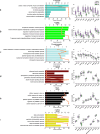Characteristics of gene expression in epicardial adipose tissue and subcutaneous adipose tissue in patients at risk for heart failure undergoing coronary artery bypass grafting
- PMID: 39375631
- PMCID: PMC11457432
- DOI: 10.1186/s12864-024-10851-9
Characteristics of gene expression in epicardial adipose tissue and subcutaneous adipose tissue in patients at risk for heart failure undergoing coronary artery bypass grafting
Abstract
Background: Epicardial adipose tissue (EAT) surrounds the heart and is hypothesised to play a role in the development of heart failure (HF). In this study, we first investigated the differences in gene expression between epicardial adipose tissue (EAT) and subcutaneous adipose tissue (SAT) in patients undergoing elective coronary artery bypass graft (CABG) surgery (n = 21; 95% male). Secondly, we examined the association between EAT and SAT in patients at risk for HF stage A (n = 12) and in pre-HF patients, who show signs but not symptoms of HF, stage B (n = 9).
Results: The study confirmed a distinct separation between EAT and SAT. In EAT 17 clusters of genes were present, of which several novel gene modules are associated with characteristics of HF. Notably, seven gene modules showed significant correlation to measures of HF, such as end diastolic left ventricular posterior wall thickness, e'mean, deceleration time and BMI. One module was particularly distinct in EAT when compared to SAT, featuring key genes such as FLT4, SEMA3A, and PTX3, which are implicated in angiogenesis, inflammation regulation, and tissue repair, suggesting a unique role in EAT linked to left ventricular dysfunction. Genetic expression was compared in EAT across all pre-HF and normal phenotypes, revealing small genetic changes in the form of 18 differentially expressed genes in ACC/AHA Stage A vs. Stage B.
Conclusions: The roles of subcutaneous and epicardial fat are clearly different. We highlight the gene expression difference in search of potential modifiers of HF progress. The true implications of our findings should be corroborated in other studies since HF ACC/AHA stage B patients are common and carry a considerable risk for progression to symptomatic HF.
Keywords: Bioinformatics; Epicardial adipose tissue; Gene expression; Heart failure; Weighted gene cluster.
© 2024. The Author(s).
Conflict of interest statement
The authors declare no competing interests.
Figures




References
-
- Packer M. Epicardial adipose tissue may mediate deleterious effects of obesity and inflammation on the myocardium. J Am Coll Cardiol. 2018;71:2360–72. - PubMed
-
- Iacobellis G, Corradi D, Sharma AM. Epicardial adipose tissue: anatomic, biomolecular and clinical relationships with the heart. Nat Clin Pract Cardiovasc Med. 2005;2:536–43. - PubMed
-
- Cherian S, Lopaschuk GD, Carvalho E. Cellular cross-talk between epicardial adipose tissue and myocardium in relation to the pathogenesis of cardiovascular disease. Am J Physiol-Endocrinol Metab. 2012;303:E937–49. - PubMed
MeSH terms
LinkOut - more resources
Full Text Sources
Medical
Research Materials
Miscellaneous

